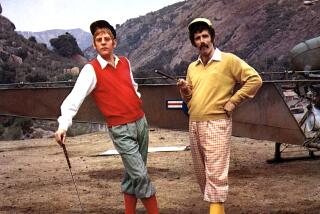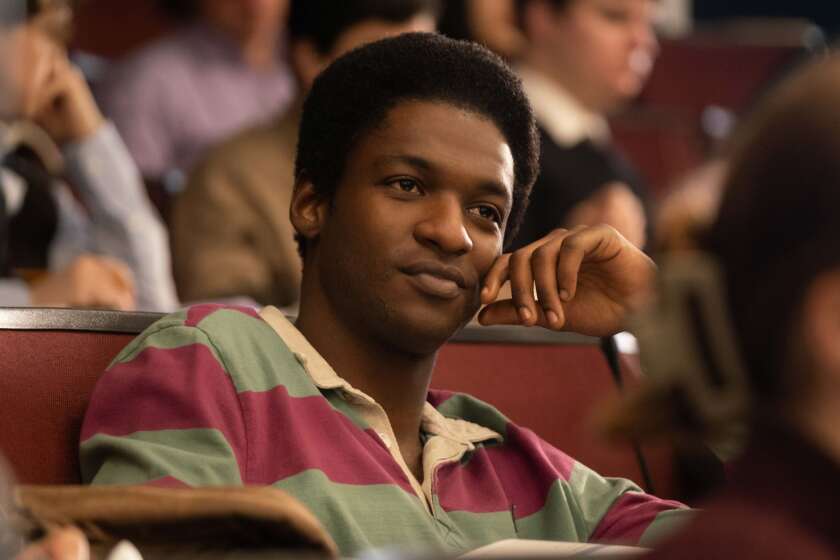Carole Eastman, 69; Wrote Screenplay for ‘Five Easy Pieces’
Carole Eastman, a highly regarded screenwriter best known for the groundbreaking 1970 film “Five Easy Pieces,” Jack Nicholson’s first starring vehicle, has died. She was 69.
Eastman, who lived in West Hollywood and wrote a number of screenplays under the pen name Adrien Joyce, died Feb. 13 at Cedars-Sinai Medical Center after a long illness.
A former ballet dancer, fashion model and actress who turned to screenwriting in the 1960s, Eastman shared an Academy Award nomination for story and screenplay with director Bob Rafelson for “Five Easy Pieces,” which also earned a “best picture” nomination.
The moody drama, in which Nicholson plays an outcast oil-well rigger with a past as a classical pianist, is credited with ushering in a new era of ambitious American films.
In an essay on “Five Easy Pieces” in the Chicago Sun-Times last year, critic Roger Ebert wrote that “the film’s greatest influence” came through the screenplay: “It allowed detours and digressions, cared more about behavior than plot, ended in a way and tone that could not have been guessed from its beginning.
“And it had moments that passed permanently into the collective memory of moviegoers.”
The most famous of those moments has come to be known as the Chicken Salad Scene, in which Nicholson’s character has a run-in with a waitress who pointedly informs him that no menu substitutions are allowed.
When his attempt to get wheat toast rather than the menu-ordained cottage fries and rolls with his omelet and coffee fails, Nicholson tries a different approach by ordering “a chicken salad sandwich on wheat toast, no mayonnaise, no butter, no lettuce.... “
“Now all you have to do is hold the chicken, bring me the toast, give me a check for the chicken salad sandwich, and you haven’t broken any rules.”
“You want me to hold the chicken, huh?” the waitress spitefully replies. To which Nicholson says: “I want you to hold it between your knees.”
The scene ends with the waitress pointing to the “no substitutions” sign.
“Do you see that sign, sir?” she says, asking him to leave. “I’m not taking any more of your smartness and sarcasm.”
“You see this sign?” Nicholson says, angrily sweeping all the water glasses and menus off the table.
Nicholson told The Times this week that Eastman “had an absolutely great vision about the foibles of people and a very idiosyncratic sense of humor, which is pretty much as she was as a person, I might add.”
Nicholson, who first met Eastman in Jeff Corey’s acting class in 1957 and considered her “one of my oldest and dearest friends,” said she was “hysterically funny. I had more laughs with Carole than just about anybody.”
Of Eastman’s work as a screenwriter, Rafelson, another longtime friend, told The Times: “I don’t think I ever met anybody -- male or female -- with such audacious and bold imagination.” He said this, combined with her sensitivity, allowed her to provide “rare insights, both into the culture and its inhabitants.”
“Here she was, this rather thin and kind of fragile-looking woman,” he said, “and she could easily write about the most obscure things like waitresses, Tammy Wynette, bowling alleys, oil fields.... There was nothing common about what Carole chose to write about.”
As a screenwriter, Nicholson said, “She went her own way and wrote what she wanted to write. Everybody was always interested in what Carole was doing.”
In addition to “Five Easy Pieces,” only five other Eastman scripts were produced: “The Fortune,” starring Nicholson and Warren Beatty; “Puzzle of a Downfall Child,” starring Faye Dunaway; “The Shooting,” starring Will Hutchins and featuring Nicholson; “Running Mates,” an HBO movie starring Diane Keaton and Ed Harris (written under the pen name A.L. Appling); and “Man Trouble,” a 1992 romantic-comedy for which she re-teamed with Rafelson and Nicholson. The film, which was critically panned and did poorly at the box office, was her last theatrical release.
In recent months, she was working on one script and had two other completed scripts in development.
Born in Glendale, Eastman grew up in Hollywood, where her family worked in the movie business: Her father was a grip at Warner Bros.; her mother was a secretary for Bing Crosby; and her uncle was a cameraman.
While attending Hollywood High School in the early 1950s, Eastman began studying ballet with Eugene Loring, a well-known choreographer who championed her work.
“When she found dance, she found what she wanted to do with her life,” her screenwriter brother, Charles, said this week. “She made every sacrifice she could to study.”
She frequently ditched school for dance classes, which led to her expulsion from Hollywood High.
“My parents were horrified,” she recalled in a 1991 interview with The Times. “Whatever would become of me without a high school diploma?”
About a year after leaving high school, Eastman’s dreams of a career as a ballerina ended when she broke her foot.
A beautiful, willowy, sandy-haired blond whom screenwriter-friend Robert Towne once described as having “a head that was shaped like a gorgeous tulip on a long stalk,” she began modeling and ultimately appeared in Vogue and other major fashion magazines. She even made a brief appearance as a model and dancer in Stanley Donen’s 1957 musical romantic-comedy “Funny Face.”
Despite her success as a model, her brother said, “She didn’t much enjoy it.”
At the same time she was modeling, he said, “she was developing as an intellect and finding that the artificiality of being a pretty lady was antagonizing.”
Turning to acting in the late ‘50s, Eastman appeared in little theater productions in Los Angeles, including one of her brother’s plays, which landed her an agent and led to television guest shots.
When her friend Monte Hellman got a job directing for Roger Corman, Hellman asked Eastman to write a script, which became the offbeat 1966 western “The Shooting” and her first produced screenplay.
Hellman this week praised her gifts as a screenwriter.
“She wrote in a very visual way,” he said. “But at the same time she had an ear: There was nobody else quite like her in terms of dialogue, nor in the way she put a script on the page.”
A memorial service for Eastman, whose brother is her only immediate survivor, is pending.
More to Read
Only good movies
Get the Indie Focus newsletter, Mark Olsen's weekly guide to the world of cinema.
You may occasionally receive promotional content from the Los Angeles Times.










